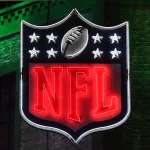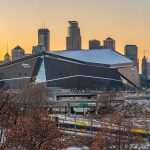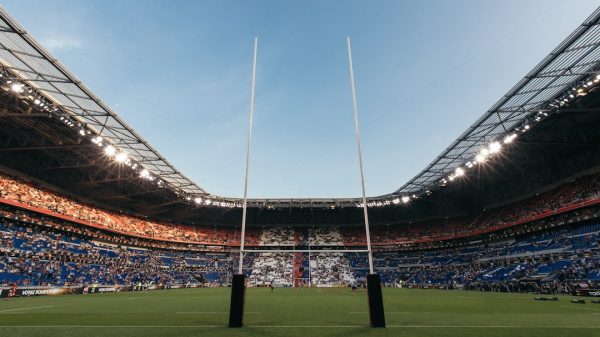dium design
– Innovations in technology and fan experience
– Examples of futuristic stadium designs
American football stadiums have a rich history that dates back to the late 19th century. The first stadiums were simple structures that provided a place for fans to gather and watch the game. Over the years, stadiums have evolved into architectural wonders, with unique features and designs that enhance the game-day experience. These stadiums have become an integral part of American culture, serving as landmarks in their cities and shaping urban landscapes. They also have a significant impact on local economies and communities, providing economic benefits and opportunities for development. In this article, we will explore the evolution of American football stadiums, their role in shaping urban landscapes, how they enhance the game-day experience, their impact on local economies and communities, the rise of multi-purpose stadiums, their influence on modern skyscraper design, the use of sustainable materials and technologies, the intersection of sports and art in stadium design, and the future of stadium design.
The Evolution of American Football Stadiums: From Simple Structures to Architectural Wonders
In the early days of American football, stadiums were simple structures that provided basic seating for fans. These early stadiums were often made of wood and had limited amenities. As the popularity of the sport grew, so did the demand for larger and more modern stadiums. The introduction of concrete and steel allowed for the construction of larger stadiums with more seating capacity. The design of these stadiums also began to evolve, with architects incorporating unique features such as domed roofs and cantilevered seating.
The impact of technology on stadium design cannot be overstated. The introduction of television broadcasting brought the game into people’s homes, leading to a greater demand for better viewing experiences at stadiums. This led to the construction of stadiums with better sightlines and improved acoustics. The advent of digital technology also allowed for the integration of video screens and other multimedia elements into stadium design.
Today, modern stadiums are architectural wonders that push the boundaries of design and technology. These stadiums are designed to provide the best possible game-day experience for fans. They feature state-of-the-art amenities such as luxury suites, club lounges, and high-definition video screens. Some stadiums even have retractable roofs and fields, allowing for games to be played in any weather conditions. Examples of modern stadiums include AT&T Stadium in Arlington, Texas, which has a retractable roof and the largest high-definition video screen in the world, and Mercedes-Benz Stadium in Atlanta, Georgia, which has a retractable roof and a circular video board that wraps around the entire stadium.
The Role of American Football Stadiums in Shaping Urban Landscapes
American football stadiums have become iconic landmarks in their cities, serving as symbols of civic pride and identity. These stadiums often have unique architectural designs that make them stand out from their surroundings. For example, Lambeau Field in Green Bay, Wisconsin, is known for its distinctive bowl shape and iconic “frozen tundra” playing surface. The stadium has become a symbol of the city’s rich football tradition and is a must-visit destination for football fans.
The construction of stadiums also has a significant impact on surrounding neighborhoods. Stadiums often serve as catalysts for urban development, attracting businesses and investment to the area. For example, the construction of MetLife Stadium in East Rutherford, New Jersey, led to the development of the Meadowlands Sports Complex, which includes hotels, restaurants, and retail outlets. The presence of the stadium has transformed the surrounding area into a vibrant entertainment district.
How American Football Stadiums are Designed to Enhance the Game-Day Experience
One of the primary goals of stadium design is to enhance the game-day experience for fans. Stadiums are designed with fan experience in mind, with amenities and features that provide comfort and convenience. For example, many modern stadiums have luxury suites and club lounges that offer premium seating and catering services. These areas provide a more exclusive and comfortable experience for fans.
Stadiums also incorporate technology to enhance the game-day experience. High-definition video screens are a common feature in modern stadiums, allowing fans to see replays and other game-related content. Some stadiums even have interactive displays and mobile apps that provide real-time statistics and other information. These technological advancements have revolutionized the way fans experience the game, bringing them closer to the action and providing a more immersive experience.
The Impact of American Football Stadiums on Local Economies and Communities
The construction of American football stadiums has significant economic benefits for local economies. Stadium construction projects create jobs and stimulate economic activity in the surrounding area. The influx of visitors for games and events also boosts local businesses such as hotels, restaurants, and retail outlets. In addition, stadiums often host other events such as concerts and conventions, further contributing to the local economy.
Stadiums also play a crucial role in community development. They serve as gathering places for residents, providing a sense of community and civic pride. Stadiums often host community events such as charity runs and youth sports programs, fostering a sense of belonging and unity. In addition, stadiums can be used as venues for cultural events such as music festivals and art exhibitions, further enriching the community.
The Rise of Multi-Purpose Stadiums: A Reflection of Changing American Values
In recent years, there has been a shift towards multi-purpose stadiums that can accommodate a variety of sports and events. This reflects changing American values and the desire for flexibility and versatility in stadium design. Multi-purpose stadiums are designed to be adaptable, with retractable seating and playing surfaces that can be configured for different sports and events.
The rise of multi-purpose stadiums also reflects the increasing importance of entertainment and leisure in American culture. These stadiums are not just venues for sports, but also for concerts, festivals, and other forms of entertainment. For example, MetLife Stadium in East Rutherford, New Jersey, has hosted major concerts by artists such as Bruce Springsteen and Beyoncé. The stadium’s flexible design allows it to accommodate a wide range of events, making it a popular destination for both sports and entertainment.
The Influence of American Football Stadiums on Modern Skyscraper Design
There is a strong connection between stadium design and skyscraper design. Many modern skyscrapers draw inspiration from the design principles used in stadium construction. For example, the curved shape of stadiums is often reflected in the curved facades of skyscrapers. The use of glass and steel in stadium construction is also common in modern skyscraper design.
Examples of skyscrapers inspired by stadium design include the Burj Khalifa in Dubai, United Arab Emirates, and the Shanghai Tower in Shanghai, China. Both buildings feature curved facades and use glass and steel extensively. These skyscrapers not only serve as architectural marvels but also as symbols of progress and innovation.
The Use of Sustainable Materials and Technologies in American Football Stadiums
Sustainability is an important consideration in stadium design. Many modern stadiums are designed to be environmentally friendly, using sustainable materials and technologies. For example, some stadiums use recycled materials in their construction, reducing the demand for new resources. Others incorporate energy-efficient systems such as solar panels and rainwater harvesting systems.
Examples of stadiums that use sustainable materials and technologies include Levi’s Stadium in Santa Clara, California, and Mercedes-Benz Stadium in Atlanta, Georgia. Levi’s Stadium is LEED Gold certified and features a green roof that helps reduce energy consumption. Mercedes-Benz Stadium has a retractable roof that is covered with a translucent material that allows natural light to enter the stadium, reducing the need for artificial lighting.
The Intersection of Sports and Art: The Aesthetics of American Football Stadiums
Stadium design is not just about functionality; it is also about aesthetics. Many stadiums are designed to be works of art, with unique architectural features and designs. These stadiums serve as cultural landmarks and symbols of artistic expression.
Examples of stadiums that are works of art include the Guggenheim Museum Bilbao in Bilbao, Spain, and the Bird’s Nest Stadium in Beijing, China. The Guggenheim Museum Bilbao is known for its distinctive curvilinear design, while the Bird’s Nest Stadium is known for its intricate lattice structure. These stadiums not only provide a venue for sports and events but also contribute to the cultural landscape of their cities.
The Future of American Football Stadium Design: Trends and Innovations
The future of American football stadium design is filled with exciting trends and innovations. One emerging trend is the use of augmented reality and virtual reality technologies to enhance the game-day experience. These technologies allow fans to have a more immersive and interactive experience, bringing them closer to the action.
Another trend is the integration of smart technology into stadium design. This includes features such as smart seating that can provide personalized experiences for fans, as well as smart lighting and climate control systems that can adjust based on occupancy and weather conditions.
In terms of innovations, there are several futuristic stadium designs that are currently being explored. For example, there are concepts for stadiums with retractable roofs made of transparent materials that allow natural light to enter the stadium. There are also designs for stadiums with floating playing surfaces that can be moved to different locations within the stadium.
In conclusion, American football stadiums have come a long way since their humble beginnings. They have evolved from simple structures to architectural wonders that enhance the game-day experience for fans. These stadiums have also played a significant role in shaping urban landscapes, revitalizing communities, and contributing to local economies. With the continued advancements in technology and design, the future of American football stadium design is sure to be filled with even more exciting innovations.
FAQs
What is the article about?
The article is about the impact of American Football stadiums on American architecture.
What is American Football?
American Football is a sport played between two teams of eleven players on a rectangular field with goalposts at each end.
How many American Football stadiums are there in the United States?
There are over 100 American Football stadiums in the United States.
What is the history of American Football stadiums?
American Football stadiums have evolved over time, from simple wooden bleachers to modern, state-of-the-art facilities with retractable roofs and high-tech video screens.
How do American Football stadiums influence American architecture?
American Football stadiums have had a significant impact on American architecture, influencing the design of other types of buildings such as airports, convention centers, and museums.
What are some examples of American Football stadiums that have influenced American architecture?
Some examples of American Football stadiums that have influenced American architecture include the Mercedes-Benz Stadium in Atlanta, the AT&T Stadium in Dallas, and the U.S. Bank Stadium in Minneapolis.
What are some of the design features of modern American Football stadiums?
Modern American Football stadiums often feature retractable roofs, high-tech video screens, luxury suites, and other amenities designed to enhance the fan experience.
What is the economic impact of American Football stadiums?
American Football stadiums can have a significant economic impact on the surrounding area, generating jobs and revenue for local businesses. However, there is debate over whether the public funding of stadiums is a wise investment.

































































































Recent Comments